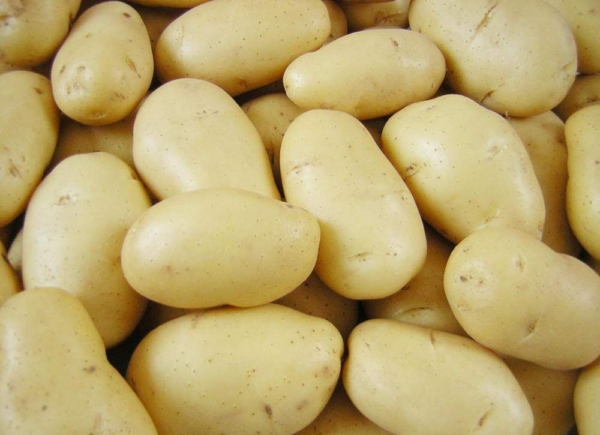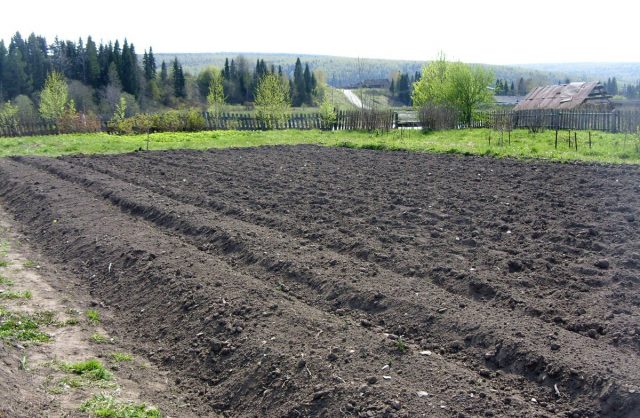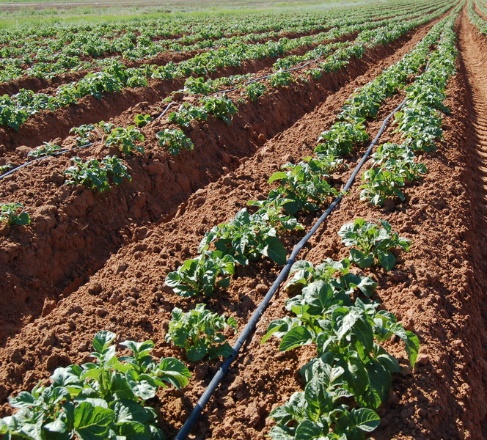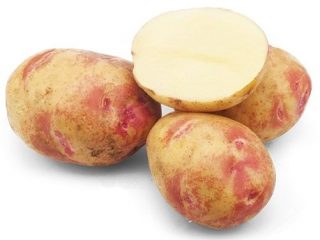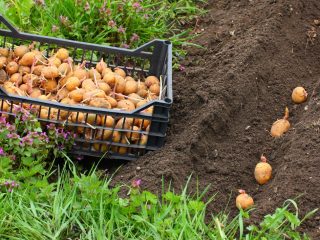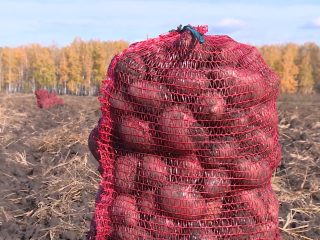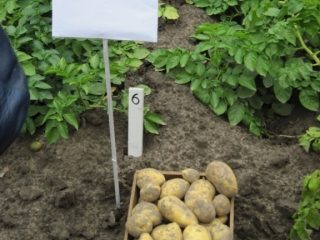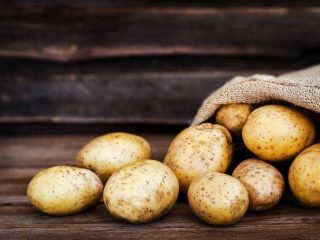Content
The description of the Madelina potato variety, photos and reviews characterize it as an early-ripening crop with high commercial and taste qualities. Potatoes of the Madeline variety are suitable for private and farm cultivation. The tubers are not damaged by mechanical harvesting and are suitable for sale washed. Madeline potatoes adapt well to soils and are a promising, high-yielding variety.
Description of potato variety Madeline
The Madeline potato variety belongs to the Dutch selection. Included in the Russian State Register of Breeding Achievements in 2011. Recommended for cultivation in the Central, Volga-Vyatka, East Siberian and Far Eastern regions. The bush is formed semi-erect, from medium to tall in size. The leaves are large, light green in color with medium to strong wavy edges. The flowers are white.
The Madelina variety is early ripening, the ripening period passes from the emergence of seedlings in 80 days. The first digging can be done after 45 days, yielding about 1 kg of potatoes per 1 square meter. m.When digging after 3 months of cultivation, the maximum yield is 3.2 kg per 1 sq. m.
The tuber is oval in shape, with a light yellow skin. Eyes – from small to medium. The pulp is creamy yellow, dense. Weight of commercial potatoes - 84-118 g. Size in length - 9-14 cm, in diameter - 7-8 cm. Product indicators - 80-93%, keeping quality - 91%.
Taste qualities of Madeline potatoes
Potatoes of the Madeline variety contain a low amount of starch - 11.6-14.7%. This indicator allows you to maintain its shape during cooking and is especially suitable for preparing soups and salads. The tuber does not change color during processing and does not darken when cut. The purpose of the variety is table.
The characteristics and reviews of the Madeline potato variety state that the taste ranges from good to excellent, depending on the growing conditions. The aroma is weak. Tubers contain an increased amount of useful micro- and macroelements, antioxidants and amino acids.
Pros and cons of the variety
The Madelina variety is well acclimatized and widely distributed throughout Russia. It is resistant to temperature changes and is not very picky about soils.
Advantages of the variety:
- early maturation;
- leveled root crops with high commercial characteristics;
- productive, with good yield;
- transports well;
- not subject to damage during various types of cleaning;
- for early culture it has good storage characteristics;
- resistance to certain diseases.
The peculiarities of the variety include the need for planting, in heated soil and pre-planting preparation of tubers. The disadvantages include instability to infection with late blight of tops.
Planting and caring for Madeline potatoes
Early potatoes of the Madeline variety contain several times more vitamins than varieties of later ripening. To obtain useful tubers, potatoes are grown on fertile soil in compliance with crop rotation. Madeline potatoes grow well after vegetables whose fruits appear above the ground, for example, peas, zucchini, and corn.
Selection and preparation of a landing site
Early potatoes are best planted in open areas on the south and southwest sides. You should not choose places, even partially shaded by trees, on the north side and areas where melt water lingers for a long time.
Growing crops on heavy and clayey soils will not bring a high yield due to the inability of the roots to move apart dense soil layers and develop properly. For planting, sandy, loose soils with neutral acidity are preferred. The planting area is enriched in advance. To do this, in the fall of the previous season, green manure is planted on the field or fertilizers are applied.
In the autumn, deep plowing of the area for planting is recommended - to a depth of 28-30 cm. In the spring, after thawing and drying of the soil, loosening is carried out. The soil for planting should not get dirty, it should be warm and crumbly.
Preparation of planting material
In the spring, when temperatures above zero, the preparation of planting material begins. Proper preparation accelerates the germination of tubers in the soil and shortens the overall development period of the plant. This allows you to get the harvest at the earliest possible date.
Tuber preparation scheme:
- Sorting. Planting material is checked and specimens with signs of bacterial and viral diseases, as well as the presence of rot or mold, are sorted.
- Calibration Seed potatoes are sorted by size. Medium and large fractions are subsequently planted separately from each other to obtain even shoots. Small-sized potatoes are not recommended for early harvest. The small supply of nutrients in such tubers slows down the emergence of seedlings.
- Germination. The tubers are laid out in the light in a warm room. When germination, it is important to observe the thermal regime; a long stay at a temperature of +20°C causes the accumulation of substances that retard growth, which reduces the quality of planting potatoes. Therefore, the temperature is +18... +20°C only in the first week, and over the next two weeks the temperature is reduced to +10°C. Humidity in the room also matters. Proper development of tubers occurs at an air humidity of 85-90%. Dry air will cause a loss of moisture in the tuber, which is necessary for plant germination in open ground. The room where potatoes are germinated should be ventilated periodically.
- Tuber processing. To protect against diseases and pest attacks, especially in the initial growth phase, tubers are treated with insecticidal and fungicidal preparations. The treatment is carried out several hours before planting so that the tubers have time to dry slightly.
During the preparation and germination of seed potatoes, an additional opportunity arises to detect infected tubers. In such potatoes, the end of the sprouts turns black. They are not suitable for planting.
Landing rules
When constant positive air temperatures exceed +10°C, potato planting begins.In different regions this is the beginning or middle of May. The usual method of planting is in rows. For an even landing, the rows are marked with a stretched cord. The distance between tubers depends on the size of the planting material and the nutritional value of the soil. The early potato variety Madeline can be planted more often than later ripening varieties. The usual planting scheme assumes a row distance of 25-30 cm, and row spacing of 70 cm.
Watering and fertilizing
The culture requires watering. On dry soils, the Madeline variety produces a weak harvest. The first watering is carried out after the green above-ground mass has grown to a height of 5-10 cm. Before this phase, the plant receives enough moisture from the mother tuber. Also during this period, the crop needs to form a strong root system.
With the further growth of the bush, it is necessary to take into account the seasonal amount of precipitation and moisten the soil, preventing it from drying out. In order for the potatoes to have the correct shape, watering must be even. Use 2-3 liters of water per bush at a time. The most effective is drip irrigation and pouring into furrows using heated water.
During the growing period, potatoes consume large amounts of nutrients from the soil. But it is best to apply mineral fertilizers in the previous season.
When nitrogen is used during the growing season, the element does not have time to decompose into a form accessible to the plant and accumulates in the root crop in the form of nitrates. Rotted manure is considered the optimal organic fertilizer for potatoes. For feeding, an infusion of grass and bird droppings is used.
Loosening and weeding
Potatoes take a long period from planting to the release of the vegetative mass. At this time, they quickly appear on the field weeds. Grasses take up large amounts of moisture and nutrients from the soil. Therefore, weeding begins already on the 5th day after planting; it is combined with loosening for better soil aeration.
Further harrowing is repeated at weekly intervals. Loosening helps break up the soil crust that forms after watering or precipitation.
Hilling
Hilling is the addition of soil from the rows to potato bushes to form high ridges. An agrotechnical technique is necessary to ensure that additional tubers are formed in the soil and that the leaf mass does not lie down. At the time of hilling, additional loosening of the soil and removal of weeds also occurs.
Hilling is carried out several times during the growing season, to a lesser extent on sandy soils. The first hilling helps to protect the plants from return frosts; it is carried out during the period when the above-ground part reaches 5-10 cm.
The second hilling is carried out a few weeks after the first, each time adding one-third of the soil to the plants. The hilling process can be replaced by mulching the plantings with cut grass or growing potatoes in green manure plantings.
Diseases and pests
The description and reviews of the Madeline potato variety indicate its susceptibility to attack by the Colorado potato beetle. Spraying with infusions with strong odors, such as garlic, helps against insects. And also planting fragrant herbs and spices next to the potatoes. Beetles prefer to attack plants with softer, weakened foliage, including those overfed with nitrogen.
The potato variety Madelina is resistant to the following diseases and pests:
- potato cancer;
- golden potato cyst nematode;
- striped mosaic;
- late blight of tubers.
Potato tops are not resistant to late blight. To combat fungal infections, preparations containing copper are used.
Potato yield
The productivity of the Madelina variety, taking into account the early ripening period, is high. 8-10 potatoes of equal size are formed on the bush. At the moment of full ripening, the yield is 2.5-3.2 kg per 1 sq. m.
Harvesting and storage
The Madelina variety can be harvested several times: in the middle and at the end of the growing season. Only fully ripened potatoes are removed for storage. It becomes mature after the tops wither and the peel thickens. Store the culture in dry, ventilated rooms at a temperature of about +2... +5°C.
Conclusion
Description of the Madelina potato variety, photos and reviews show a productive crop for growing on personal and farm farms. Leveled potatoes with smooth skin and weak eyes are well suited for sale and storage. The variety is distinguished by its early ripening with the possibility of the first digging after 45 days. Adapts well to the soil and climate in the growing area.
